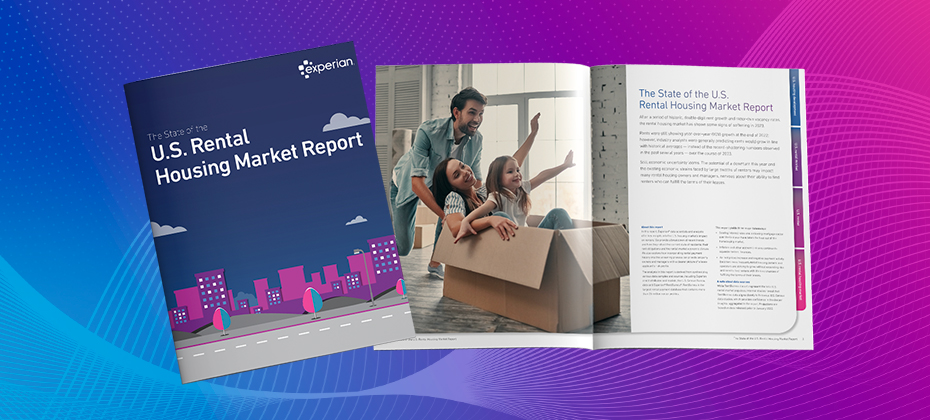Tag: rent bureau

As 2023 unfolds, rental housing owners and operators find themselves faced with a slightly different market than in the recent past. While rents are still high, rent growth has slowed somewhat, and the prospect of a cooler U.S. economy means more renters could be facing economic hardships in the months ahead. So, who is today's renter? In The State of the U.S. Rental Housing Market, a new report from Experian, we uncover that today’s renters are typically younger. According to our data derived from Experian RentBureau® and our analysis, 68.8% of today’s renters are either millennials (41.8%) or Gen Z (27%). Meanwhile, 17.3% are Gen X, 11.9% are baby boomers and only 2.2% are from the Silent Generation. Similarly, when you look at the renters who have a higher propensity to move — and thus need a new apartment or home to rent — they tend to skew younger. Our analysis shows that, of the renters who made two or more moves during the last two years, 43.2% were Gen Y (millennials). The younger Gen Y segment accounts for 25.2% of the frequent movers. As the population of renters has increased over the past decade, the concentration of growth appears to be among households earning $75,000 or more in annual income. About 7.6 million of these households were renters in 2009; by 10 years later, that figure had increased to 11.2 million. What is their financial status? Also, by some measurements, U.S. consumers — and, by extension, renters — improved their financial standing during the pandemic era. Credit scores rose as consumers used stimulus payments to pay down debt and save, but this trend is starting to normalize. The median conventional credit score rose above 700 in 2022, up from just above 680 in 2019. Still, according to Experian RentBureau, 63% of all renter households are low- to moderate-income earners, meaning they make less than 80% of the area median income. Furthermore, the average renter spends 38.6% of their income on rent. Households that spend more than 30% of their income on housing costs — including rent or mortgage payments, utilities and other fees — are considered “housing cost burdened” by the U.S. Department of Housing and Urban Development. For more insight and analysis of today’s rental-housing market, click here to download your free copy of The State of the U.S. Rental Housing Market report.

After a period of historic, double-digit rent growth and razor-thin vacancy rates, the rental housing market has shown some signs of softening in recent months. And economic uncertainty still looms. The potential of a downturn this year and the existing economic strains faced by large swaths of renters may impact many rental-housing owners and managers nervous about their ability to find renters who can fulfill their lease terms. In The State of the U.S. Rental Housing Market, a new report from Experian, our data scientists and analysts offer key insights into the U.S. housing market and its impact on renters. The analysis in this report is derived from synthesizing various data samples and sources, including Experian credit attributes and models as well as data from the U.S. Census Bureau and Experian RentBureau®. Experian RentBureau is the largest rental payment database and contains over 4.4 million transactions and more than 25 million renter profiles. This report yields three major takeaways: Soaring interest rates and a slowing mortgage sector over the last year have taken heat out of the homebuying market, leading to more renters remaining in the renter pool. Inflation and other economic strains continue to squeeze renters’ finances. As rent prices increase and negative payment activity becomes more frequent, rental-housing owners and operators are striving to grow without expanding default risk and need to find renters with the best chances of fulfilling the terms of their leases. Among the report’s other notable findings: The average renter spends 38.6% of their income on rent. Households that spend more than 30% of their income on housing costs — including rent or mortgage payments, utilities and other fees — are considered “housing cost burdened” by the U.S. Department of Housing and Urban Development. Experian data shows 28% of renters with negative payment activity in 2022 (negative payment activity is defined as having late charges, insufficient funds, write-offs or outstanding balances). The figure represented an increase of 5.7 percentage points from 2021 and 3.8 percentage points from 2020. Also of note, low-to-moderate income renters are twice as likely to have a negative payment activity compared to other renters. Rent-to-income ratios are highest in the West and the Northeast. Among all 50 states, the leaders are Washington D.C. (40.9%), California (39.7%), Washington state (35.6%), Utah (35.6%) and New York (35.3%). Keep pace with trends in future blog posts that will dive deeper into the current conditions affecting the rental housing market and renters. In the meantime, click here to download your free copy of The State of the U.S. Rental Housing Market Report in full.

It's one thing to make a corporate commitment to financial inclusion, but quite another to set specific goals and measure outcomes. What goals should lenders set to make financial inclusion a reality? How can success be quantified? What actionable steps must be taken to put policy into practice? The road to financial inclusion may feel long, but this step-by-step checklist can help you measure diversity and achieve goals to become more inclusive as an organization. Step 1: Set quantifiable goals with realistic outcomes Start by defining what you plan to achieve with a financial inclusion strategy. When setting goals, Alpa Lally, Experian's Vice President of Data Business at Consumer Information Services, recommends organizations "assess the strategic opportunity at the enterprise level." "It is important that KPIs are aligned across each business unit and functional groups in order to understand the investment opportunity and what the business must achieve together," said Lally. "The key focus here is 'together', the path to financial inclusion is a journey for all groups and everyone must participate, be committed and be aligned to be successful." Figuring out your short- and long-term goals should be the first step to kickstarting a financial inclusion strategy. But equally important is driving towards outcomes. For instance, if the goal is to increase the number of loans made to previously overlooked or excluded consumers, you may want to start by examining your declination population to better understand who is being left out. Or if financial inclusion is tied to a wider strategy or vision on corporate social responsibility, your goals may include an education component, community outreach, and a re-examination of your hiring practices. No matter what KPIs you're using, here are relevant questions to ask in four key areas – which will help draw out your organizational goals and priorities: Organizational awareness: What action is your organization taking to enhance Diversity, Equity and Inclusion and embrace Corporate Social Responsibility (CSR) around financial inclusion? If you already have financial inclusion programs in place, what are the primary goals? Barriers: What barriers prevent the organization from pursuing equity, diversity and inclusion programs? Education: How do you create awareness and education around financial inclusion? Which community or third-party organizations can help you reach consumers who aren't aware of ways to access financial services? Markers of success: What benchmarks will your organization use to measure and analyze success? Step 2: Do a financial inclusion audit Before developing and implementing a robust financial inclusion program, Lally recommends conducting a financial inclusion audit – which is a "detailed assessment of where you are today, relative to the goals and results you've outlined". In a nutshell, it allows you to assess your current systems and results within your financial institution. According to Lally, a financial inclusion audit should address the following key areas: Roadmap: What are your strategic priorities and how will financial inclusion fit within them? Tracking: Track the actual volume and distribution of different underserved populations (e.g., young adults, low-income communities, immigrants, etc.) within your book of business. Look at the applications and the approval rates by segment. In addition, assess the interest rates these consumers are offered by credit score bands for each group: “Benchmarking is critical. Understanding how they compare to national averages? How do they compare to the rest of your portfolio?" said Lally. Hiring practices: Is diversity, equity and inclusion (DEI) central to your talent management strategy? Is there a link between a lack of DEI in hiring practices and the level of financial inclusion within an organization? Affordability and access: Determine if the products and services you offer are easily accessible, can be understood by a reasonable consumer and are affordable to a broad base. Internal practices: What policies exist that influence the culture and behavior of employees around financial inclusion? Partnerships: Identify outside organizations that can help you develop financial literacy programs to promote financial inclusion. Advertising: Does your advertising promote equal and diverse representation across a wide range of consumer groups? Tools to measure: Are you financially inclusive as a company? How can you improve? The Bayesian Improved Surname Geocoding (BISG) method used by the Consumer Financial Protection Bureau (CFPB) predicts the probability of an individual's race and ethnicity based on demographic information associated with the consumer's surname. Lenders can use this type of information to conduct internal audits or set benchmarks to help ensure accountability in their diversity goals. Step 3: Tap into technology New technology is emerging that gives lenders powerful tools to evaluate a wider pool of prospective borrowers while also mitigating risk. For instance, scoring models that incorporate expanded FCRA-regulated data provide greater insight into 'credit invisible' or 'unscorable' consumers because they look at a wider set of data assets (or 'alternative data'), which allows lenders to assess a larger pool of applicants. It also improves the accuracy of those scores and better assesses the creditworthiness of consumers. Consider these resources, among others: Lift Premium™: Experian estimates that lenders using Lift Premium™ can score 96 percent of U.S. adults, a vast improvement over the 81 percent that are scorable today with conventional scores relying on mainstream data. Such enhanced scores would enable six million consumers who are considered subprime today to qualify for “mainstream" (prime or near-prime) credit. Experian® RentBureau®: RentBureau collects rent payment data from landlords and management companies, which allows consumers to leverage positive rent payment history similarly to how consumers leverage consistent mortgage payments. Clarity Credit Data: Clarity Credit Data allows lenders to see how consumers use alternative financial products and examine payment behaviors that might exist outside of the traditional credit report. Clarity's expanded FCRA -regulated data provides a deeper view of the consumer, allowing lenders to identify those who may not have previously been classified as "at risk" and approve consumers that may have previously been denied using a traditional credit score. Income Verification: Consumers can grant access to their bank accounts so lenders can assess their ability to pay based on verified income and cash flow. In addition, artificial intelligence (AI) and greater automation can reduce operational costs for lenders, while increasing the affordability of financial products and services for customers. AI and machine learning (ML) can also improve risk profiling and credit decisioning by filling in some of the gaps where credit history is not available. These are just a few examples of a wide range of cutting-edge solutions and technologies that enable lenders to promote greater financial inclusion through their decisioning processes. As new solutions are introduced to the market, it is imperative that lenders look into these technologies to help grow their business. Step 4: Monitor and measure Measuring your progress on financial inclusion isn't a one-and-done proposition. After you've set your goals and created a roadmap, it's important to continue monitoring and measuring your progress. That means your performance to gauge the impact of financial inclusion at both the community and business levels. Lally recommends the following examples: Compare your lending pool to the latest population data from the United States census. Is your portfolio representative of the U.S. population or are there segments that should have greater access? How does it compare against other lenders competing in the same space? Keep in mind that it has been widely reported that certain populations were undercounted, so you may want to factor this reality into your assessments. Work to understand how traditionally underserved consumers are performing in terms of their payment behaviors, purchase patterns and delinquencies. Measure the impact of financial inclusion on your company's overall revenue growth, ROI and brand reputation. Conduct an analysis to better understand your company's brand reputation, how it's perceived across different groups and what your customers are saying. Last word Financial inclusion represents a big step towards closing the wealth gap and helping marginalized communities build generational wealth. Given the prevalence of socioeconomic and racial inequality in our country today, it's a complex issue that disproportionately impacts marginalized groups, such as consumers of color, low-income communities and immigrants. Adopting more financially inclusive practices can help improve access to credit for these groups. For financial institutions and lenders, the first step is to identify realistic, quantifiable goals. A successful financial inclusion initiative also hinges on completing a financial inclusion audit, tapping into the right technology and continually monitoring and measuring progress. "It is paramount that financial institutions hold themselves accountable and demonstrate their commitment to make these practices a part of their DNA." - Alpa Lally. Learn more

On June 7, the Consumer Financial Protection Bureau (CFPB) released a new study that found that the ways “credit invisible” consumers establish credit history can differ greatly based on their economic background. The CFPB estimated in its May 2015 study "Data Point: Credit Invisibles" that more than 45 million American consumers are credit invisible, meaning they either have a thin credit file that cannot be scored or no credit history at all. The new study reviewed de-identified credit records on more than one million consumers who became credit visible. It found that consumers in lower-income areas are 240 percent more likely to become credit visible due to negative information, such as a debt in collection. The CFPB noted consumers in higher-income areas become credit visible in a more positive way, with 30 percent more likely to become credit visible by using a credit card and 100 percent more likely to become credit visible by being added as a co-borrower or authorized user on someone else’s account. The study also found that the percentage of consumers transitioning to credit visibility due to student loans more than doubled in the last 10 years. CFPB’s research highlights the need for alternative credit data The new study demonstrates the importance of moving forward with inclusion of new sources of high-quality financial data — like on-time payment data from rent, utility and telecommunications providers — into a consumer’s credit file. Experian recently outlined our beliefs on the issue in comments responding to the CFPB’s Request for Information on Alternative Data. As a brand, we have a long history of using alternative credit data to help lenders make better lending decisions. Extensive research has shown that there is an immense opportunity to facilitate greater access to fair and affordable credit for underserved consumers through the inclusion of on-time telecommunications, utility and rental data in credit files. While these consumers may not have a traditional credit history, many make on-time payments for telephone, rent, cable, power or mobile services. However, this data is not typically being used to enhance traditional credit files held by the nationwide consumer reporting agencies, nor is it being used in most third-party or custom credit scoring models. Further, new advances in financial technology and data analytics through account aggregation platforms are also integral to the credit granting process and can be applied in a manner to broaden access to credit. Experian is currently using account aggregation software to obtain consumer financial account information for authentication and income verification to speed credit decisions, but we are looking to expand this technology to increase the collection and utilization of alternative data for improving credit decisions by lenders. Policymakers should act to help credit invisible consumers While Experian continues to work with telecommunications and utility companies to facilitate the furnishing of on-time credit data to the nationwide consumer reporting agencies, regulatory barriers continue to exist that deter utility and telecommunications companies from furnishing on-time payment data to credit bureaus. To help address this issue, Congress is currently considering bipartisan legislation (H.R. 435, The Credit Access and Inclusion Act of 2017) that would amend the FCRA to clarify that utility and telecommunication companies can report positive credit data, such as on-time payments, to the nation' s credit reporting bureaus. The legislation has bipartisan support in Congress and Experian encourages lawmakers to move forward with this important initiative that could benefit tens of millions of American consumers. In addition, Experian believes policymakers should more clearly define the term alternative data. In public policy debates, the term "alternative data" is a broad term, often lumping data sources that can or have been proven to meet regulatory standards for accuracy and fairness required by both the Fair Credit Reporting Act and the Equal Credit Opportunity Act with data sources that cannot or have not been proven to meet these standards. In our comment letter, Experian encourages policymakers to clearly differentiate between different types of alternative data and focus the consumer and commercial credit industry on public policy recommendations that will increase the use of those sources of data that have or can be shown to meet legal and societal standards for accuracy, validity, predictability and fairness. More info on Alternative Credit Data More Info on Alternative Financial Services